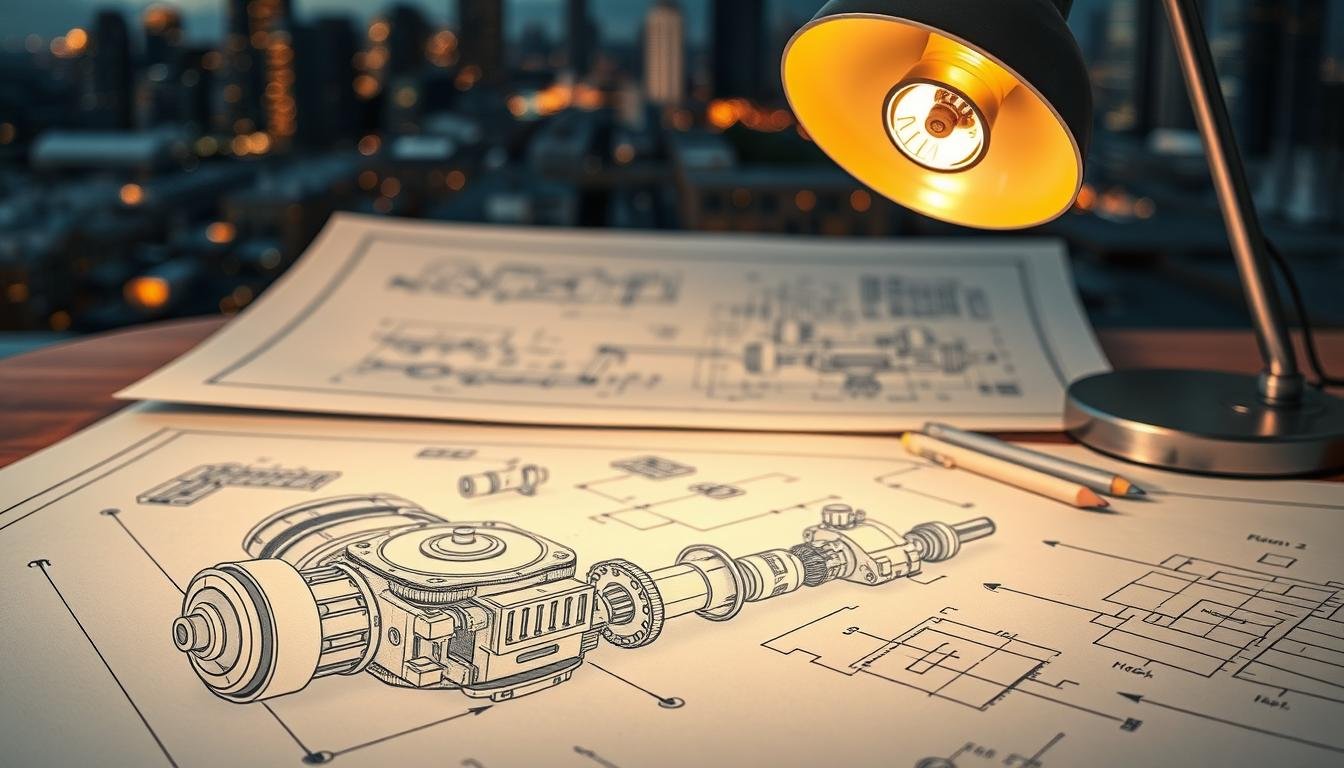In today’s fast-changing engineering world, a good manual of engineering drawing is key. It helps both students and professionals. This guide offers important tips on precision and clarity in design.
By learning from this manual, I can improve my drawing skills. This lets me tackle tough design problems with ease. Knowing how to draw well is essential for making a big impact in my field.
Introduction to Engineering Drawing:
In this section, I will explore the basics of engineering drawing. These foundational elements are key for anyone interested in technical drafting. Engineering drawings are vital in engineering and architecture. They act as a universal language, clearly showing design intent, specifications, and operational instructions.
The history of engineering drawing shows how technology has changed the field. From hand-drawn sketches to advanced CAD systems, the approach to technical drafting has evolved. Learning the basics of engineering drawing improves skills and prepares you for more complex techniques.
Understanding these basics helps aspiring drafters and engineers face future challenges with confidence. Mastering the basics of engineering drawing gives them the skills to create precise and functional designs. These designs meet industry standards.
Essential Techniques for Effective Engineering Drawing:
Mastering key techniques in engineering drawing boosts my illustration quality. I focus on line weight and types, which are key to showing design features. Using different weights and styles makes my drawings easier to read and understand.
Dimensions and annotations are also critical. Following best practices, I make sure every label is clear and correct. This attention to detail helps create schematics that are easy to follow. It also ensures my diagrams meet industry standards, making sure my message is clear.
Understanding Drawing Standards and Conventions:
In my study of engineering drawing, I see how key drawing standards and drafting conventions are. Groups like ANSI and ISO set these rules. They help keep drawings consistent and accurate across many fields.
By following these guidelines, I make sure my drawings are top-notch. This helps everyone understand them clearly, no matter where they’re from. It makes teamwork better and cuts down on mistakes that could cost a lot.
Benefits of a Manual of Engineering Drawing:
A manual of engineering drawing is key for anyone in engineering. It offers many benefits for learning and using engineering drawing skills. These manuals help understand complex concepts in engineering drawing.
As I grow in my career, I see how these manuals are helpful. They make sure I know the theory and can apply it well. For new engineers, they make starting work easier and build a strong base for the future.
These manuals are also great for experienced engineers. They help us quickly remember important standards and techniques. This keeps us up to date with industry standards.
They also help us be creative and try new designs. But we always follow the right practices. This is very important for my career.
In short, a manual of engineering drawing is very important. It helps us grow and learn in our careers. It’s useful in schools and in real engineering work.
The Role of Symbols in Engineering Drawings:
Symbols are key in engineering drawings. They help me share information quickly and clearly. Each symbol stands for complex parts, making it easy for others to understand without long explanations.
In fields like electrical, mechanical, and civil engineering, symbols are a must. For instance, circuit diagrams use special symbols for different parts. Knowing these symbols makes my drawings clear, helping me work well with others.
Getting the meaning of these symbols makes my drawings very useful. A good schematic can show processes and functions easily. It makes complex information simple to see.
Applications of Engineering Drawings in Project Development:
Engineering drawings are key in project development. They help team members, stakeholders, and contractors understand the design. This ensures everyone is on the same page.
These drawings are also vital for meeting regulations. Many industries have strict rules. Good drawings show that a project follows these rules, building trust with everyone involved.
Engineering drawings are also important in making products. They give detailed plans for manufacturers. This makes sure products are made right and meet quality standards.
Using engineering drawings improves project coordination and reduces mistakes. They make projects more efficient. I’ve seen how good designs lead to successful projects that meet expectations and standards.
Insights on 3D Modeling and Engineering Drawing:
The link between 3D modeling and traditional engineering drawing is changing fast. CAD software is now key in design, making 3D modeling a big plus. It brings out fine details that help everyone understand and talk about designs better.
3D models let us test and tweak ideas before making them real. This teamwork between engineers and designers makes the design process smoother. It also makes projects more accurate, cuts down on mistakes, and speeds up work.
Future Trends in Engineering Drawing Practices:
Looking ahead, technology will change engineering drawing a lot. Tools like artificial intelligence are making drafting faster and more accurate. Soon, AI might help engineers create complex drawings by suggesting the best designs from big data sets.
Augmented reality (AR) and virtual reality (VR) will also change how we use engineering drawings. These technologies let designers see projects in 3D, making teamwork better. I think AR and VR will make it easier to work with 3D models, helping us share ideas more clearly.
As technology advances, so will the rules for engineering drawings. I predict we’ll see more flexible standards that work with new tech but keep things clear. This change will keep engineering drawing relevant, driving innovation and better understanding among everyone involved.
